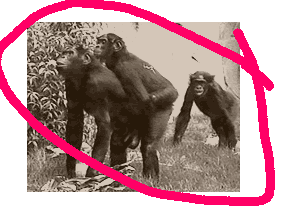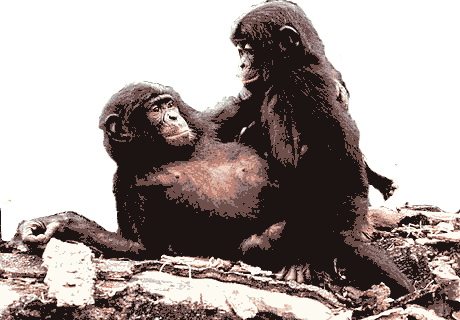LES BONOBOS SUBSTITUENT
LE SEXE À LA VIOLENCE

Chimpanzé et bonobo se ressemblent beaucoup, mais la violence du premier fait place à une sexualité débridée chez le second. À qui l'humain ressemble-t-il le plus?
Le bonobo, un proche cousin du chimpanzé, est connu depuis 1929, mais n'a été étudié sur le terrain que depuis les années 70. Cet animal étonnamment proche de nous a révolutionné la perception qu'ont les primatologues des origines de l'humanité. Alors que les chimpanzés règlent leurs conflits par la violence, les bonobos, eux, ont recours à une sexualité parfois débridée pour les résoudre. Dès lors, les primates, dont l'homme, n'apparaissent plus comme des créatures condamnées aux luttes de pouvoir.
Les chimpanzés forment une société dominée par les mâles, contrairement à ce qui se passe chez les bonobos, où ce sont les femelles qui dominent le groupe. Les deux espèces pratiquent la chasse en groupe et le partage de la nourriture, mais seuls les chimpanzés connaissent des affrontements politiques et même une forme primitive de guerre.
C'est que chez les bonobos, le sexe se substitue à l'agressivité. Tant les mâles que les femelles connaissent l'orgasme. Les pratiques sexuelles de ces singes étonnants comprennent des attouchements à deux ou à plus, entre partenaires de sexe opposé ou non, ainsi que le baiser sur la bouche, la masturbation, la fellation et la copulation dans toutes les positions, y compris celle du missionnaire qui est censée être le propre de l'homme...
Cette sexualité débridée, notent les primatologues, encourage le partage et sert à apaiser les tensions ou à se réconcilier. Elle permet aux bonobos de se mettre à la place de l'autre. Comparé au chimpanzé, le bonobo est un maître de la communication sociale. Son cousin ne l'emporte que dans la manipulation d'objets et dans l'orientation spatiale. Et de qui l'humain est-il le plus proche? Difficile à dire, mais l'étude du bonobo jette un curieux éclairage sur nos sociétés.
[texte écrit par Philippe Gauthier et piqué par accident sur: www.cybersciences.com]
Voici en anglais un autre texte qui documente la réalité des bonobos plus en profondeur.
BONOBO SOCIETY:
AMICABLE, AMOROUS
AND RUN BY FEMALES

Nature's raucous bestiary rarely serves up good role models for human behavior, unless you happen to work on the trading floor of the New York Stock Exchange. But there is one creature that stands out from the chest-thumping masses as an example of amicability, sensitivity and, well, humaneness: a little-known ape called the bonobo, or, less accurately, the pygmy chimpanzee. Before bonobos can be fully appreciated, however, two human prejudices must be overcome. The first is, fellows, the female bonobo is the dominant sex, though the dominance is so mild and unobnoxious that some researchers view bonobo society as a matter of "co-dominance," or equality between the sexes. Fancy that.
The second hurdle is human squeamishness about what in the 80s were called PDAs, or public displays of affection, in this case very graphic ones. Bonobos lubricate the gears of social harmony with sex, in all possible permutations and combinations: males with females, males with males, females with females, and even infants with adults. The sexual acts include intercourse, genital-to-genital rubbing, oral sex, mutual masturbation and even a practice that people once thought they had a patent on: French kissing.
Bonobos use sex to appease, to bond, to make up after a fight, to ease tensions, to cement alliances. Humans generally wait until after a nice meal to make love; bonobos do it beorehand, to alleviate the stress and competitiveness often seen among animals when they encounter a source of food.
Lest this all sound like a nonstop Caligulean orgy, Dr. Frans de Waal, a primatologist at Emory University in Atlanta who is the author of "Bonobo: The Forgotten Ape," emphasizes otherwise. "Sex is there, it's pervasive, it's critical, and bonobo society would collapse without it," he said in an interview. "But it's not what people think it is. It's not driven by orgasm or seeking release. Nor is it often reproductively driven. Sex for a bonobo is casual, it's quick and once you're used to watching it, it begins to look like any other social interaction." The new book, with photographs by Frans Lanting, will be published in May by the University of California Press. In "Bonobo," de Waal draws upon his own research as well as that of many other primatologists to sketch a portrait of a species much less familiar to most people than are the other great apes -- the gorilla, the orangutan and the so-called common chimpanzee. The bonobo, found in the dense equatorial rain forests of Zaire, was not officially discovered until 1929, long after the other apes had been described in the scientific literature.
Even today there are only about 100 in zoos around the country, compared with the many thousands of chimpanzees in captivity. Bonobos are closely related to chimpanzees, but they have a more graceful and slender build, with smaller heads, slimmer necks, longer legs and less burly upper torsos. When standing or walking upright, bonobos have straighter backs than do the chimpanzees, and so assume a more humanlike posture.
Far more dramatic than their physical differences are their behavioral distinctions. Bonobos are much less aggressive and hot-tempered than are chimpanzees, and are not nearly as prone to physical violence. They are less obsessed with power and status than are their chimpanzee cousins, and more consumed with Eros.
As de Waal puts it in his book, "The chimpanzee resolves sexual issues with power; the bonobo resolves power issues with sex." Or more coyly, chimpanzees are from Mars, bonobos are from Venus. All of which has relevance for understanding the roots of human nature. De Waal seeks to correct the image of humanity's ancestors as invariably chimpanzee-like, driven by aggression, hierarchical machinations, hunting, warfare and male dominance. He points out that bonobos are as genetically close to humans as are chimpanzees, and that both are astonishingly similar to mankind, sharing at least 98 percent of humans' DNA. "The take-home message is, there's more flexibility in our lineage than we thought," de Waal said. "Bonobos are just as close to us as are chimpanzees, so we can't push them aside."
Indeed, humans appear to possess at least some bonobo-like characteristics, particularly the extracurricular use of sex beyond that needed for reproduction, and perhaps a more robust capacity for cooperation than some die-hard social Darwinists might care to admit. One unusual aspect of bonobo society is the ability of females to form strong alliances with other unrelated females. In most primates, the males leave their birthplaces on reaching maturity as a means of avoiding incest, and so the females that form the social core are knit together by kinship. Among bonobos, females disperse at adolescence, and have to insinuate themselves into a group of strangers. They make friends with sexual overtures, and are particularly solicitous of the resident females.
The constructed sisterhood appears to give females a slight edge over resident males, who, though they may be related to one another, do not tend to act as an organized alliance. For example, the females usually have priority when it comes to eating, and they will stick up for one another should the bigger and more muscular male try to act aggressively. Female alliances may have arisen to counter the threat of infanticide by males, which is quite common in other species, including the chimpanzee, but has never been observed among bonobos.
De Waal said that many men grow indignant when they learn of the bonobo's social structure. "After one of my talks, a famous German professor jumped up and said, 'What is wrong with these males?' " he recalled. Yet de Waal said the bonobo males might not have reason to rebel. "They seem to be in a perfectly good situation," he said. "The females have sex with them all the time, and they don't have to fight over it so much among themselves. I'm not sure they've lost anything, except for their dominance."
Text by Natalie Angier
Source: New York Times
More infos:
https://www.unl.edu/rhames/bonobo/bonobo.htm